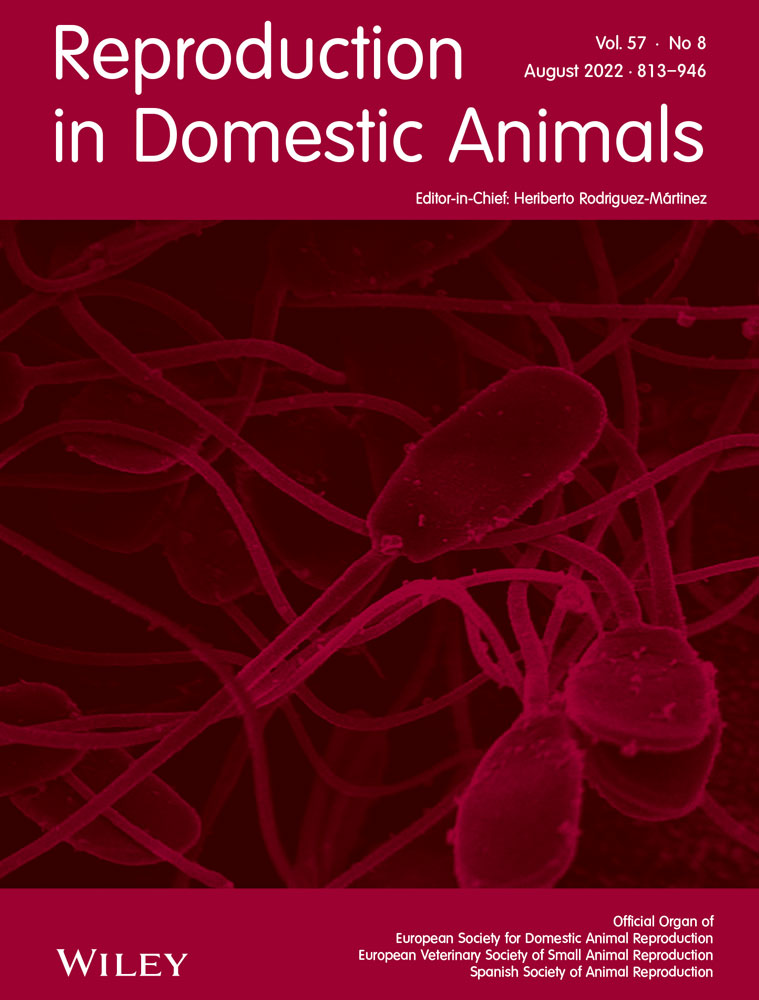Heat stress during critical windows of the oestrous cycle and risk of pregnancy establishment in embryo-recipient dairy heifers
Abstract
This study aimed to determine effects of exposure of recipient dairy heifers to heat stress (THI ≥ 73) during the oestrous cycle coinciding with embryo transfer (ET) on the risk of pregnancy establishment after transfer of in vivo produced embryos. Recipients exposed to THI values ≥73 during Days zero (recipient estrus), 7 (day of ET), 14 (seven days after ET), 15 and 16 (maternal recognition of pregnancy) of the ET cycle were considered as heat-stressed heifers (n = 254), while heifers in the control group (n = 470) were not exposed to THI ≥ 73 at any of the previous days. Results revealed no significant effects of any of the investigated factors on the risk of pregnancy following ET. However, the mean THI above 77 was associated with a drastic numerical decrease in PR/ET (36.63%), when compared to a mean THI 72 (78.78%). In addition, PR/ET after transfer of second- and third-grade embryos were numerically lower in heat-stressed recipients, compared with first-grade embryos (41.17% vs. 56.36%, respectively). Our findings confirmed that transfer of blastocysts was associated with numerically higher PR/ET in heat-stressed and control recipients, as compared to morula stage. Interestingly, PR/ET tended to be higher when sexed embryos were transferred to the control recipients compared with heat-stressed ones. In conclusion, PR/ET in dairy heifers was not significantly affected by heat stress during critical windows of their oestrous cycle coinciding with ET, whereas transfer of sexed embryos gives lower results under conditions of heat stress.
1 INTRODUCTION
Global warming is an international alarming phenomenon that affects all aspects of life including animal biology. Environmental heat stress is associated with compromised reproductive performance in mammals, particularly animals under stressful conditions (De Rensis et al., 2021). Temperature–humidity index (THI) is the most important indicator of the degree of heat stress to which dairy animals are exposed (Ratchamak et al., 2021) as it combines effects of both ambient temperature and relative humidity. Heat-stressed cows show poor reproductive performance and achieve lower conception rates when compared to non-stressed herd-mates, particularly when inseminated using sexed semen (Oikawa et al., 2019). Despite the modern cooling technologies and its favourable consequences on conception rates during hot summer months, embryo transfer (ET) is still representing the most effective strategy to overcome the negative impacts of heat stress on conception in dairy cows (Hansen, 2019). Research evaluating benefits of ET on fertility of heat-stressed dairy cattle focus on two main aspects, and the first compares conception rates to ET with those established after artificial insemination reporting favourable consequences of ET on pregnancy, compared with AI, except when vitrified–thawed in vitro produced embryos were transferred (Drost et al., 1999) due to problems of freezing protocols. The second compares PR/ET between hot and cold seasons of the year, reporting no seasonal variations in pregnancy with some exceptions where PR/ET was higher during winter when fresh (Block & Hansen, 2007) or frozen-thawed (Chebel et al., 2008) in vitro produced embryos were transferred. Application of the previous findings on MOET embryos produced by superovulation still needs further validations. Additionally, the majority of previous research in this regard has been carried out in recipient cows with variable ages, production levels and days in milk; whether or not this applies for dairy heifers is still not clear. In addition, most of the research investigating effects of THI on PR/ET have investigated the effects on ET day without emphasis on critical windows of embryonic development after transfer to recipients. Furthermore, the ability of sexed embryos or inferior quality embryo grades to establish pregnancy in recipients under conditions of summer heat stress has not received extensive research.
Maternal recognition of pregnancy in cattle occurs in response to an interaction between the elongated embryo on Days 16 to 17 of gestation and the uterine environment, chiefly through production of embryonic interferon-tau and the initiation of this process begins on Day 13 after fertilization (Bazer & Thatcher, 2017; Sánchez et al., 2019). Based on a recent study (Kasimanickam & Kasimanickam, 2021), exposure of dairy cows to heat stress (THI ≥ 73) for 21 days before insemination was associated with lower gestational Day 7 and Day 16 conception rates and Day 16 conceptus from heat-stressed cows showed stunted elongation. Accordingly, it may be proposed that exposure of embryo recipients to heat stress during the first 16 days of oestrous cycle in which they are submitted to ET may be associated with lower PR/ET. To the best of our knowledge, research regarding effects of heat stress of recipient heifers during the cycle in which embryos produced by superovulation were transferred on establishment of pregnancy is scarce and requires further investigation. Thus, we planned the current study to study effects of heat stress (THI ≥ 73) of recipients during the oestrous cycle coinciding with embryo transfer on PR/ET in dairy heifers and to determine different factors contributing to pregnancy establishment under heat stress conditions as embryo stage, embryo quality and type (sexed vs. non-sexed) and their possible interactions with THI.
2 MATERIAL AND METHODS
2.1 Animals and data
The study was carried out in a well-managed dairy herd in North-western Egypt (30°.66 North, 30°.06 East ‘Figure 1’). Heifers were housed in free, partially shaded yards allowing 25 square metre for each heifer and 70 cm feed-bunk space for feeding. Animals had free access to clean fresh water all over the day. A total of 992 embryos were transferred to recipient dairy heifers on different days of the year during the period from January 2017 to July 2021. Heifers averaged 398.5 ± 10.4 kg and aged 14.5 ± 0.5 months at embryo transfer.
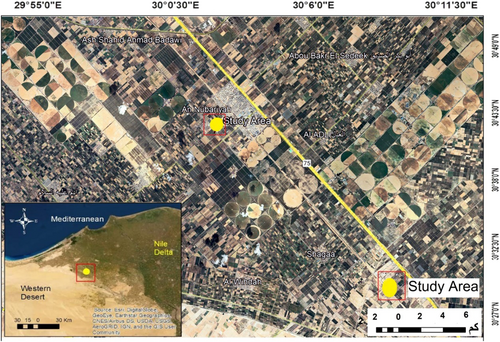
2.2 Protocol of superovulation, embryo grading and embryo transfer
Embryos were acquired by superovulation of superior donor cows in the same herd (Abdel Aziz et al., 2017; Mapletoft & Bó, 2011) using pFSH. The process of superovulation and embryo production included annual treatment of cows from January to March where donor cows were submitted to superovulation in sets of nine cows per session. After flushing of donor cows, embryos were graded according to (Bó & Mapletoft, 2018) depending on colour and shape of the embryo, percentage of irregular blastomeres and viable embryonic cells. Grade one embryos were frozen and were transferred as frozen-thawed embryos, while second- and third-grade embryos were transferred as fresh embryos.
First-grade embryos were frozen according to the protocol described by Youngs (2011) and were kept in liquid nitrogen till being transferred. The thawing procedures included thawing in a thawing device for 30 s at 30°C. Second- and third-grade embryos were transferred fresh into prepared recipient heifers after being loaded into 0.25 ml straws. Standard ET guns were used for transferring embryos. Some of the second- and third-grade embryos were frozen and were transferred after thawing under heat stress conditions.
Recipient heifers were examined rectally on Day 6 after confirmed oestrus to assess the quality of CL using ultrasonography (B-mode, 7 MH linear probe; BFC Technology) and only heifers with good quality CL were chosen as embryo recipients. On Day 7 after oestrus, the heifers were given a light dose of epidural anaesthesia (2–4 ml of Lidocaine 2%) and the perineum was washed using water and soap and then dried before ET. Each recipient received an embryo non-surgically into the uterine horn ipsilateral to the ovary containing CL.
2.3 Calculation of temperature–humidity index (THI)
Daily fluctuations of ambient temperature and relative humidity were provided by the Egyptian meteorological authority regarding the prevailing temperature and relative humidity around the farm. THI was calculated according to the equation provided by (Kendall & Webster, 2009): THI = (1.8 × AT + 32) − [(0.55 − 0.0055 × RH) × (1.8 × AT − 26)], where AT corresponds to ambient temperature and RH refers to relative humidity.
THI was recorded during Days zero (oestrus), 7 (ET), 14, 15 and 16 of the oestrous cycle in which embryos were transferred. Recipients exposed to THI ≥ 73 during the five days were considered heat stressed; meanwhile, recipients that were exposed to THI < 73 during the five days were considered as control group.
2.4 Pregnancy diagnosis
Recipient heifers were examined for pregnancy on Day 35 after embryo transfer using trans-rectal ultrasonography (B-mode 7 MHz linear transducer; BCF Technology). Pregnancy was confirmed after visualization of proper embryo and appearance of anechoic fluids around it inside the echogenic regularly rounded amnion.
2.5 Data recorded at ET
Regarding the transferred embryos, data belonging to sire's breed, stage of embryonic development (morula, early blastocyst and blastocyst), embryo state (fresh or frozen-thawed), grade (first, second and third) and sexing (sexed and non-sexed) were recorded. As per recipient heifers, only recipient breed was recorded. We did not record recipients’ data as it did not vary among recipients receiving embryos at similar ages, body weights and after confirmation of a satisfactory CL. It is noteworthy that recipients had not been inseminated before ET. Furthermore, only one experienced veterinarian carried out the processes of ET.
2.6 Statistical analyses
Data were analysed using SPSS, version 22. Variations of PR/ET between different categories were tested using chi-squared analysis. In addition, a binary logistic regression analysis was carried out to determine variables influencing PR/ET. Independent variables included numerical variables THI at oestrus, THI at ET, THI seven days after ET, THI 8 days after ET, THI 9 days after ET, and mean THI (mean THI value of the previous five THI readings), and categorical variables embryo quality grade (Excellent: 1, Good: 2 or Fair: 3), embryo stage (Morula:1 or Blastocyst: 2), embryo state (fresh:1, or frozen-thawed: 2), recipient breed (Holstein:1 or Simmental: 2) and season of transfer (Cold season: 1 or Hot season: 2) with possible interactions. A p value less than .05 was considered significant.
3 RESULTS
3.1 Effects of THI during the oestrous cycle coinciding with ET on PR/ET in recipient dairy heifers
Figure 2 illustrated effects of the mean THI of the five recorded values corresponding to Days zero, 7, 14, 15 and 16; to which recipient dairy heifers were exposed during their ET oestrous cycle on pregnancy rates after ET. According to the data displayed in the figure, recipient heifers exposed to a mean THI (72) achieved 78.78% PR/ET. This value decreased to 36.63% in heifers receiving embryos at a mean THI of 78. However, no statistical differences were observed among different mean THI categories.
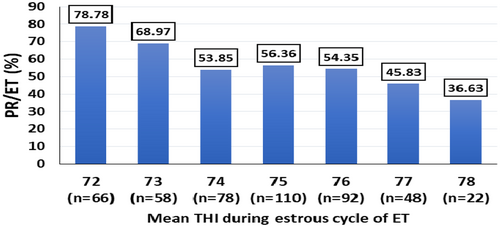
The effects of heat stress (THI ≥ 73) on PR/ET in recipient heifers are demonstrated in Figure 3. No significant differences were detected between heat-stressed and control heifers regarding PR/ET (54.33% vs. 53.62%, Chi-square = 0.32, p > .05).
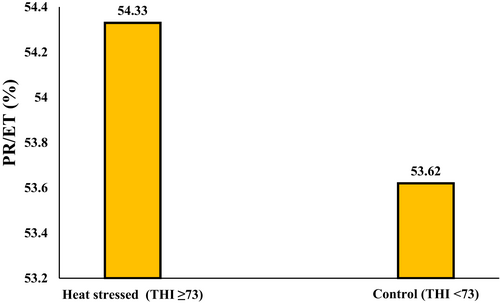
3.2 Effect of heat stress (THI ≥ 73) versus, embryo grade on PR/ET in recipient dairy heifers
Figure 4 represented effects of heat stress on PR/ET established after transfer of different embryo quality grades. We did not find significant differences (Chi-square = 5.33, p > .05) among embryo quality grades (First vs. second and third) after transfer to heat-stressed (56.36% vs. 41.17%) or control recipients (56.46% vs. 48.86%). Yet, it seems that second and third quality embryos achieve better PR/ET if transferred during the cold season (THI < 73).
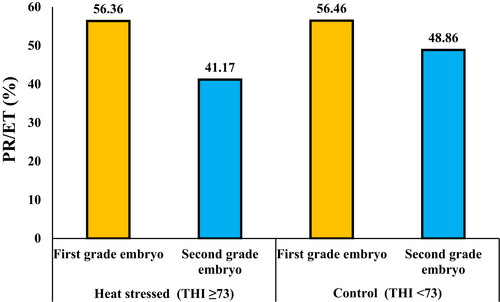
3.3 Effect of heat stress (THI ≥ 73) versus, stage of transferred embryo on PR/ET in recipient dairy heifers
The information displayed in Figure 5 represented effects of heat stress (THI ≥ 73) on pregnancy establishment in recipient heifers according to the stage of transferred embryo. Although transfer of a blastocyst stage achieved approximately 10% higher PR/ET under heat stress and control conditions, the variations in pregnancy rates were not significantly different among groups (61.63 vs. 51.22 and 60.27% vs. 51.25% in heat-stressed and control recipients, respectively, chi-square = 4.72, p > .05).
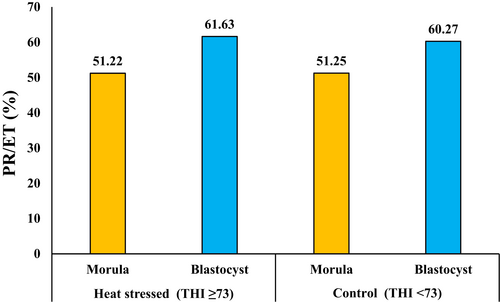
3.4 Effect of heat stress (THI ≥ 73) versus, type of transferred embryo (sexed versus non-sexed) on PR/ET in recipient dairy heifers
Interactions between effects of heat stress and type of transferred embryo (sexed or non-sexed) on the risk of pregnancy in recipient dairy heifers are depicted in Figure 6. Transfer of sexed embryos to heat-stressed recipients gave 35.71% PR/ET, while non-sexed embryos achieved 56.64% PR/ET. This finding was not reproduced between embryo categories transferred to control recipients where PR/ET was 52.50% for sexed embryos and 53.85% for non-sexed embryos. Yet, statistical significance was not reached among groups, in spite of a statistical tendency (Chi-square = 6.47; p = .07).
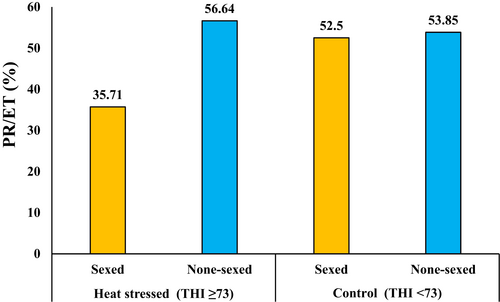
3.5 Effect of breed on the risk of pregnancy establishment in heat-stressed and control recipients
As demonstrated in Figure 7, there were no statistical differences (Chi-square = 5.36, p > .05) between Holstein and Brown Swiss recipient heifers in PR/ET when embryos were transferred to heat-stressed recipients (53.85% vs. 56.52%) or to the control group (51.88% vs. 69.57%).
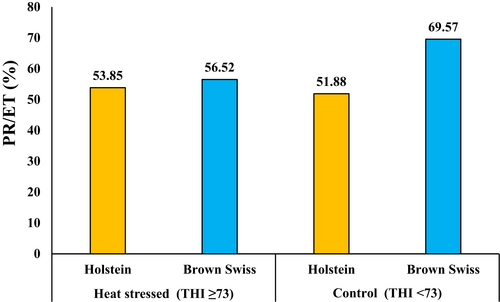
4 DISCUSSION
The present study investigated the effects of THI during the oestrous cycle coinciding with ET on the risk of pregnancy establishment in embryo-recipient dairy heifers. We calculated THI values for five critical days coinciding with important events (Day 1: oestrus; Day 7: Day of ET; Day 14: initiation of embryo elongation; Days 15 and 16: maternal recognition of pregnancy). It is well known that conception is higher in heifers, compared with parous lactating cows due to several physiological and stress-related causes (Maillo et al., 2012; de Oliveira Marques et al., 2015). Thus, dairy heifers were selected as recipients to surpass several cow-related factors, which may modify the resultant PR/ET. We hypothesized that embryos transferred to recipients during heat stress conditions prevailing at critical windows of the oestrous cycles coinciding with ET (day of oestrus, day of ET: first exposure of an embryo to a new uterine environment, Days 14, 15 and 16 of recipient cycle: embryonic elongation and maternal recognition of pregnancy) may exhibit lower developmental potential and become less able to establish and maintain pregnancy in recipient dams, but findings from the current study contradicted our hypothesis with only one important observation where investigation of the effects of mean THI to which recipients were exposed at the ET cycle revealed that there is decreasing trend in PR/ET with increased mean THI; nevertheless, differences among variable mean THI levels are not significant as observed in Figure 2. Drastic declines in PR/ET were observed in recipients whose mean THI values were 78 (36.63%). However, this finding should be interpreted with great caution due to the low number of embryos transferred in the last group (mean THI 78). In accordance, (Ferraz et al., 2016) showed that PR/ET was significantly higher in recipients at THI < 72, compared with that observed in recipients at THI greater than 79. In that study, there was no difference in PR/ET between THI < 72 and 72–79. Sartori et al. (2002) reported that heifers have the ability to regulate body temperature more efficiently than parous cows. This implies that nulliparous heifers are more heat tolerant than cows and that adverse effects of THI would be encountered in heifers at values greater than that specified for cows (>72).
As regard to effects of heat stress (THI ≥ 73) during the recipient's oestrous cycle coinciding with ET on PR/ET, no differences were observed between heat-stressed recipients and the control group. Similar results were reported in heat-stressed dairy cows on ET day (Baruselli et al., 2020; Hansen, 2019). This finding is mainly based on the fact that seven-day-old bovine embryo acquires a state of thermotolerance and resists adverse effects of elevated internal temperatures of the recipient dam during heat stress; thus, ET has been widely employed to compensate the low conception figures achieved in cows during summer months (Hansen, 2020). In addition, heifers do not suffer from lactational stressors, which would potentiate the negative effects of heat stress as observed in lactating dairy cows (West, 2003). Hence, absence of effects of thermal stress (THI ≥ 73) on PR/ET is a logic consequence in the current study. Future research employing higher THI thresholds to investigate heat stress effects on recipient heifer fertility after ET should be carried out.
Numerically higher PR/ET was observed after transfer of first-grade embryos, compared with second- and third-grade embryos, particularly during heat stress. In addition, the abilities of grade one embryos to establish pregnancy in recipients did not vary between heat-stressed and control heifers; meanwhile, second- and third-grade embryos were less likely, although not significant, to achieve pregnancy during heat stress (THI ≥ 73) in the present study. Notably, few numbers of second- and third-grade embryos were transferred during heat stress conditions. Similar results were reported previously regarding superior PR/ET after transfer of first-grade embryos (Erdem et al., 2020; Ferraz et al., 2016). It is likely that first-grade embryos have greater developmental potential after transfer into recipient uteri. When the second- and third-grade embryos were transferred fresh, that is under conditions in which recipients were not exposed to heat stress; they were more able to achieve pregnancy; meanwhile, during heat stress, the second- and third-grade embryos were transferred frozen-thawed (because embryo production has been carried out during cool months of the year). Frozen-thawed second- and third-grade embryos transferred under heat stress conditions have limited ability to establish pregnancies, when compared to those transferred as fresh embryos or first-grade frozen-thawed embryos (Sudano et al., 2013).
As demonstrated in Figure 5, heat stress of the embryo recipient during the ET oestrous cycle did not affect the risk of pregnancy in both morula and blastocyst stages. This means that both morula and blastocyst embryos are heat resistant and can tolerate heat stress (Hansen, 2020). But referring to the effect of embryo stage on pregnancy establishment, blastocyst transfer led to approximately 10% higher PR/ET either in heat-stressed or in control recipients. Although not significant, this finding is in accordance with those from previous studies (Baruselli et al., 2020; Erdem et al., 2020) that attributed the greater abilities of blastocysts to establish pregnancy to their advanced stage of development.
Heat stress negatively influenced the resultant PR/ET after transfer of sexed embryos in the present study, while comparable PR/ET was achieved by control recipients regardless of embryo sexing. Effects of semen used in MOET-embryo production (sexed vs. conventional) on the risk of pregnancy establishment in dairy heifers under conditions of heat stress have not been clarified to the best of our knowledge. Mikkola et al. (2015) reported that PR/ET was 5%–7% higher after transfer of MOET embryos produced by conventional semen, compared with sexed embryos, but no information was available regarding environmental impacts. A study on IVP embryos revealed that PR/ET was nearly 3 points higher in cows receiving embryos produced by sexed sperm (Rasmussen et al., 2013). Stewart et al. (2011) compared PR/ET following transfer of fresh or vitrified–thawed in vitro produced embryos under heat stress conditions and found greater PR/ET when sexed embryos were transferred fresh to recipient cows. In our study, however, we transferred fresh sexed embryos during cool months, while sexed embryos were transferred frozen-thawed under heat stress conditions during summer. It is plausible that sexed embryos might have been less resistant to freezing-thawing procedures than those produced by conventional semen, thereby failed to achieve satisfactory pregnancy rates under summer heat stress conditions.
Findings from the current study showed no significant effects of recipient breed on the risk of pregnancy establishment after ET. Nevertheless, when embryos were transferred to Brown Swiss recipient heifers during the cool period of the year, PR/ET was greater than that in Holstein recipients (69.57% vs. 51.88%, respectively) but without statistical difference. This finding was not reproduced during heat stress period (56.52% vs. 53.85%, respectively). PR/ET have been affected by cattle breeds selected as embryo recipients in previous researches (Arreseigor et al., 2016; Looney et al., 2006). According to Karasahin et al. (2021), recipient breed was a major factor affecting success of pregnancy after ET in cows treated using flunixine meglumine after comparison of Angus and Holstein recipient cows. In that study, PR/ET was lower in Holstein recipients, compared with Angus counterparts and it was attributed to the adverse effects of high milk yield on fertility in Holstein cows. However, that finding cannot be applied in the present study as we used heifers as recipients of dairy breeds. Future research work including greater numbers of Brown Swiss recipients should be carried out for validation of our finding controlled for several factors affecting pregnancy establishment after ET.
One criticism of the present study would be that no estimation of circulating progesterone levels has been carried out at any of the specified time points at which THI values were calculated. It is clear that circulating progesterone levels and the patterns of progesterone rise after oestrus play an important role in maintenance of early pregnancy, particularly during the first seven days after oestrus. In the present study, embryos were transferred to recipients on Day seven after onset of oestrus, and the quality of recipient CL was assessed using ultrasonography. Strong correlations between luteal progesterone production and CL ultrasonographic measurements have been reported (Rocha et al., 2019). In accordance, Kaneko and Takagi (2014) reported that ultrasonography can be used to estimate the functionality of a CL based on luteal tissue ultrasound measurements. Hence, submission of recipient heifers in our work has been based on acceptable CL quality indicating no variations in serum progesterone levels.
5 CONCLUSION
The present study showed that exposure of embryo-recipient dairy heifers to heat stress (THI ≥ 73) during the oestrous cycle of embryo transfer did not have significant effects on pregnancy success. Moreover, none of the investigated factors significantly affected the risk of pregnancy following ET. Nevertheless, numerical differences in PR/ET were observed based on embryo quality, embryo stage, embryo state and recipient breed. Further research involving higher numbers of animals is warranted to validate the numerical differences observed in the present study.
CONFLICT OF INTEREST
The authors declare no conflicts of interest.
AUTHOR CONTRIBUTIONS
RLA, MMH, HE, MAAM and AA contributed equally to this work. Methodology, analysis of data and writing of the manuscript were done mostly by all authors. RLA and AA finished the final version of the manuscript and approved the final form.
Open Research
DATA AVAILABILITY
The data that support the findings of this study are available from the corresponding author upon reasonable request.



